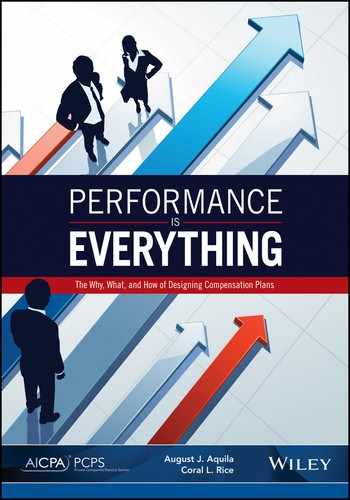Preface
Performance Is Everything is our second book about compensation for professional services firms. Our first book, Compensation as a Strategic Asset: The New Paradigm, attempted to capture in one place the current state of compensation plans used by CPA firms throughout North America and summarized our knowledge about how they were working. It also offered an introduction to implementing a pay-for-performance system. The two books are meant to complement each other. A great deal of practical information in the first book is not repeated in this second book, but it is still very relevant.
After we started writing this book, we realized it would be impossible to write about compensation without looking at the firm as a whole. Over the years, many articles have been written about owner and employee compensation, but compensation problems still exist in most firms. Our research shows that over half of owners in firms today are dissatisfied with the current compensation system, and most owners do not have written goals tied to bonus compensation.
Performance Is Everything comes from our current thinking based on our work over the past five years with firms that were facing compensation challenges. As we worked with more clients, it became clear that firms need not only to choose the right compensation plan for their practices (and not just copy another firm’s plan) but to develop an overall system that encompasses and links performance management and compensation. It also became clear that firm leaders lacked an understanding about how to align their compensation systems with the firm’s strategic initiatives and the key choices available when designing a compensation plan and how to best make them. So, we have worked with firms to help them design compensation plans that are easier to understand and administer, fairer, and based on performance. We now know more about compensation plans than we did five years ago and expect to know even more five years from now.
Our approach to helping firms achieve better, if not superior, performance started with the reward element: compensation. We soon realized the puzzle was more complex than figuring out how to split the pie.
This book is a new perspective on the crucial topics of performance and rewards. It’s like the old, traditional saying about love and marriage—“You can’t have one without the other.” We address the core subject of building a high-performance firm, no matter its size. We also address the need to create structures and systems that align with the firm’s strategies because we know now that high performance does not happen in a vacuum.
Our intention is to convey, in simple and clear terms, how firms can improve overall firm performance by engaging in the following activities:
Develop a compelling vision.
Develop a strategy for what you want to accomplish.
Have the right systems in place to help achieve the strategy.
Align individual goals with firm and departmental goals.
Create an effective performance review system.
Monitor performance monthly and quarterly for trends.
Provide higher performers with more rewards than average performers.
This is not theory. This is what firms must do to retain high performers and generate higher profits. Rewards are not something you consider at the end of the year; they are an integral part of firm management. Our objective is for you to take that understanding and mold it to your own practice.
Although the accounting profession has not drastically changed over the years, the management of an accounting practice certainly has changed. This will not only continue, but we expect it to accelerate. It will be up to firm leaders to prepare their firms for tomorrow. They must learn how to manage their firms successfully to compete for clients and talent and to grow profits.
Performance depends on the firm’s structure, governance, and management and service to clients. This, too, is what this book is: managing a firm to achieve superior performance and meeting the needs of its people and, above all, providing extraordinary service to its clients.
The ideas, suggestions, and orientations of this book are not derived from abstract theory about what a firm should be. They are based, rather, on the broad and extensive experience we both have had as consultants, practitioners in accounting firms, and executives in public companies—more than 60 years between us. Most of what we write about in this book, however old, however new, stems from our experience and firsthand knowledge of what works. We offer no advice other than that which we know to be practical and viable and that has delivered a track record of results. We have also drawn from comparable experiences of fellow innovative practitioners and sound advisers.
Compensation is a firm’s largest expenditure, but few firms do a good job managing it. We know that a compensation system can inspire or discourage people, inspire peak performance or a leisurely stroll through the valley, motivate the right and wrong people to stay or go, and encourage your people to provide outstanding client service. A good compensation plan can advance your firm to new levels of strategic and financial success. A poorly designed compensation plan, however, may motivate owners and employees to do the wrong things.
There is much more to learn about how to structure the contemporary accounting firm to meet its goals and properly serve its clients. We know this is not the last book written on this topic, but we hope we have contributed to the overall body of knowledge and provided new ideas and perspectives for you, our readers.
August Aquila and Coral Rice
June 2012
